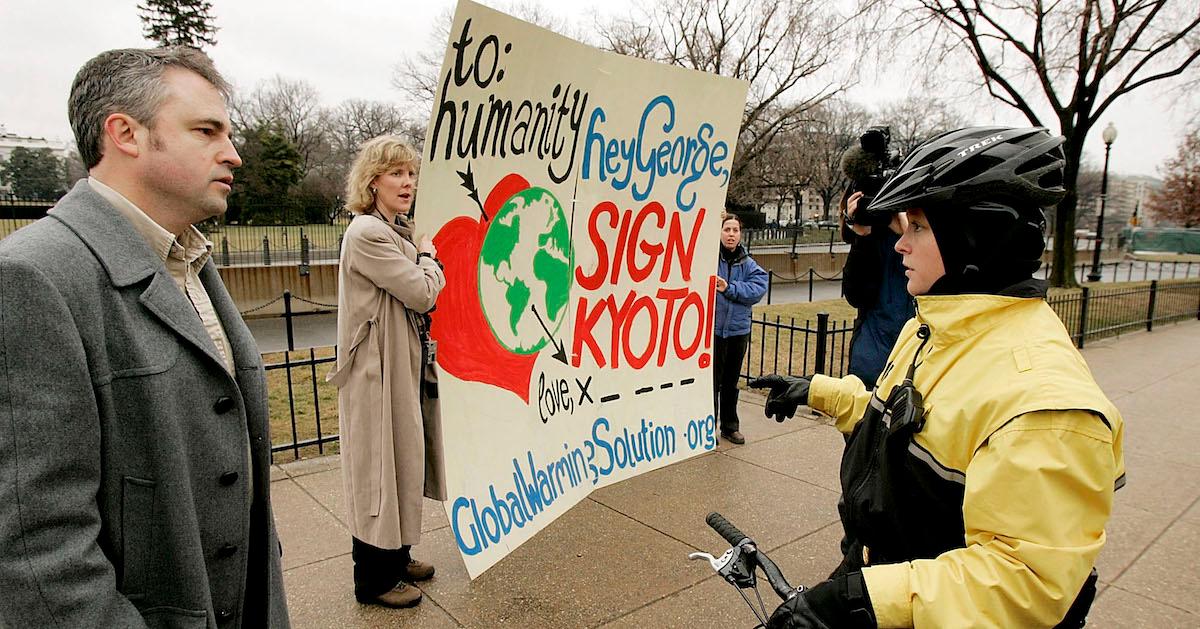The Kyoto Protocol: What You Need to Know About the Paris Agreement's Predecessor
Published Sept. 16 2022, 1:14 p.m. ET

Before the Paris Agreement, there was the Kyoto Protocol, a treaty that aimed to bring together every country on Earth to reduce emissions and fight climate change — with a focus on pressuring the countries who bear the most responsibility for the climate crisis.
But what exactly is the meaning of the Kyoto Protocol, and is the agreement still in effect?
The Kyoto Protocol's origins:
According to the United Nations Framework Convention on Climate Change (UNFCCC), the Kyoto Protocol is an international treaty that was signed as part of the UNFCCC.
Nearly every country in the world signed the agreement in Kyoto, Japan on Dec. 11, 1997. However, it did not become ratified until Feb. 16, 2005, and its first commitment period did not start until 2008.
Today, there are 192 Parties to the Kyoto Protocol, representing nearly every country on Earth. However, the Annex I Parties are the several dozen countries and economies that bear the most responsibility to the Kyoto Protocol.
All that being said, what exactly is the meaning of the Kyoto Protocol?

A U.S. Secret Service officer talks to David Merrill, Executive Director of the National Global Warming Coalition, while he was urging U.S. President George W. Bush to sign the Kyoto Protocol during a protest on the Ellipse behind the White House, on Feb. 14, 2005.
The Kyoto Protocol meaning: Here’s what the treaty aims to do.
As explained by the UNFCCC, the Kyoto Protocol binds its signatories to following the UNFCCC’s principles. That said, it is only legally binding to the as Annex I Parties, which are countries classified as industrialized and developed, as these countries hold far more responsibility for producing greenhouse gas emissions.
The convention asks these countries to try and achieve certain targets by following mitigation measures, and to report their progress to the convention.
So what are these principles?
In short, the UNFCCC recognized the seriousness of anthropogenic climate change and set an emissions-reduction goal for the entire planet. It aimed to do this by using the Kyoto Protocol putting pressure on Annex I Parties to take the lead, for these parties to give financial support to developing countries that are bearing the brunt of climate change, and keep track of emissions and report them.
The Kyoto Protocol’s first commitment period ran from 2008 until 2012. It set different emissions-reduction targets for each of the Annex I Parties, which would average out to a 5 percent emission reduction from 1990 levels. At this time, the Annex I Parties represented 37 countries and economies from around the world, as well as the European Union.
When this commitment period ended, a few changes were made to the group of Annex I Parties — for instance, Canada officially withdrew from the Kyoto Protocol in 2011, as per CNN. This means that the Annex I Parties for the second commitment period slightly differed from the first commitment period.
What is the Doha Amendment? It represents the Kyoto Protocol’s second commitment period.
On Dec. 8, 2012, the Kyoto Protocol adopted the Doha Amendment, which was signed in Doha, Qatar. This declared the Kyoto Protocol’s second commitment period as 2013 through 2020.
By the time the second commitment period expired on Dec. 31, 2020, the amendment had received enough ratifications to enter into force. So on that day, the Doha Amendment formally went into effect, establishing the past second commitment period, according to IISD.
According to a UN press release in October 2020, the Doha Amendment’s “entry into force is critical for the rigorous and successful implementation of the second commitment period of the Kyoto Protocol.”
Today, the Doha Amendment holds Annex I Parties responsible for reducing GHG emissions further — by 18 percent below 1990 levels. It also includes a revised group of GHGs that parties must report on.
Additionally, the Doha Amendment puts a greater emphasis on the Kyoto Protocol’s “intent to assist developing countries with low or insignificant greenhouse gas emissions but are suffering the consequences to access financial assistance to support efforts to adapt to the impacts of climate change.”
All that being said, some see the Paris Agreement of 2015, aka the Paris Climate Accord, as “effectively replacing” the Kyoto Protocol, as it was signed by every one of the UNFCCC’s 196 signatories. For instance, the U.S. is actually not a party to the Kyoto Protocol, but it is to the Paris Agreement (despite Trump's efforts to withdraw the country).